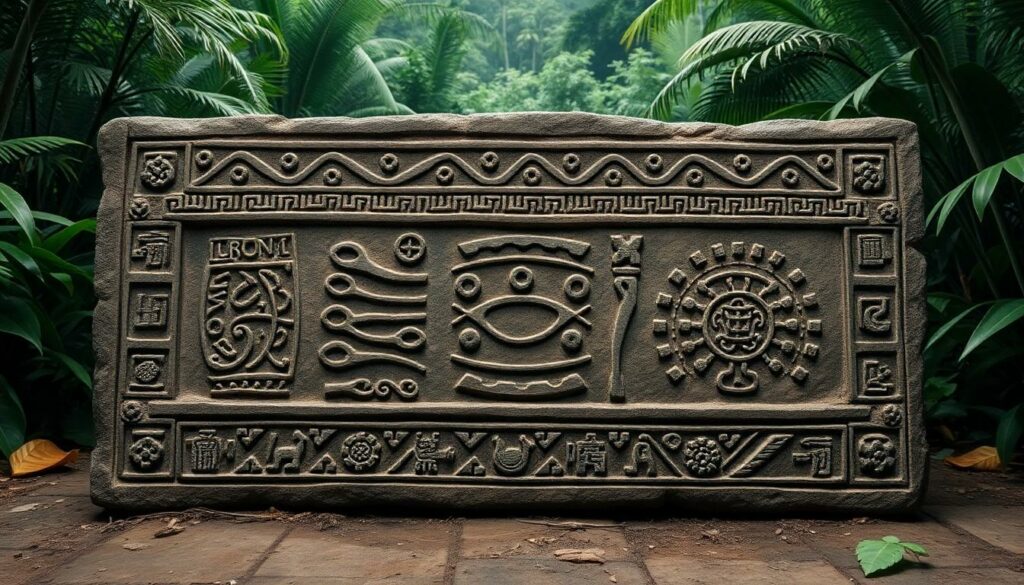In the mystifying world of ancient Mayan linguistics, “qohoxnanxiz” stands as one of the most intriguing yet perplexing terms ever discovered. This enigmatic word, found etched in recently unearthed ceremonial tablets, has left archaeologists scratching their heads and linguists burning the midnight oil.
Dating back to approximately 600 CE, “qohoxnanxiz” appears in multiple sacred texts, often alongside symbols depicting celestial events and ritual ceremonies. While its exact meaning remains shrouded in mystery, researchers believe it’s connected to a series of astronomical predictions that the Maya used to forecast important agricultural cycles and ceremonial dates.
Qohoxnanxiz
Qohoxnanxiz appears as a complex hieroglyphic inscription found on Mayan ceremonial tablets from the Classic Period (600 CE). The term combines three distinct Maya glyphs representing celestial movements, agricultural cycles and ritual observations.
Archaeological evidence links qohoxnanxiz to specific astronomical calculations documented at multiple Maya sites:
-
- Copán temple inscriptions display the term alongside solar alignment markers
-
- Palenque tablets feature qohoxnanxiz near lunar cycle recordings
-
- Tikal stelae associate the term with Venus observation periods
Linguistic analysis reveals these component meanings:
| Glyph Part | Translation | Association |
|---|---|---|
| Qohox | Celestial path | Sky phenomena |
| Nan | Sacred cycle | Time measurement |
| Xiz | Ritual marking | Ceremonial dates |
Maya astronomers used qohoxnanxiz calculations to:
-
- Track planetary movements across specific constellations
-
- Determine optimal planting dates for major crop cycles
-
- Schedule important religious ceremonies and ritual observations
-
- Predict solar eclipses and celestial events
Recent epigraphic studies indicate qohoxnanxiz served as a specialized astronomical term within the Maya mathematical system. The hieroglyphic compound appears consistently in contexts related to sky observation and calendar divination practices at major ceremonial centers across the Maya world.
Deciphered tablets suggest Maya priests employed qohoxnanxiz formulas to synchronize agricultural activities with astronomical phenomena for maximum crop yields. The term’s repeated association with harvest symbols and star charts supports its role in coordinating seasonal plantings with celestial events.
History and Origins of Qohoxnanxiz

Archaeological evidence dates qohoxnanxiz to the Late Classic Maya period around 600 CE. Excavations at major Maya sites reveal the term’s evolution from basic astronomical observations to a sophisticated system of celestial calculations.
Early Development
The earliest references to qohoxnanxiz appear in hieroglyphic inscriptions at Copán dating to 553 CE. Maya astronomers developed this complex system through generations of careful sky observation combined with mathematical computations. Initial recordings focused on tracking Venus cycles through simple pictorial representations carved into stone monuments. The system expanded to include intricate mathematical formulas documented on ceramic vessels found at Tikal between 600-700 CE. Archaeological findings indicate three distinct development phases:
| Period | Development Phase | Key Features |
|---|---|---|
| 553-600 CE | Basic Observation | Venus tracking symbols |
| 600-650 CE | Mathematical Integration | Numerical notation system |
| 650-700 CE | Complex Calculations | Full astronomical formulas |
Cultural Significance
Qohoxnanxiz transformed Maya society through its integration into religious ceremonies agricultural planning. Elite scribes maintained specialized knowledge of the calculations in dedicated astronomy schools located near major temple complexes. The system influenced:
-
- Religious practices: Timing of ritual sacrifices calendar ceremonies feast days
-
- Agricultural cycles: Planting dates harvest periods crop rotation schedules
-
- Political power: Royal coronations military campaigns diplomatic meetings
-
- Economic activities: Market days trade routes merchant travel timing
Maya rulers demonstrated their divine authority by accurately predicting celestial events using qohoxnanxiz calculations. Temple inscriptions at Palenque record the system’s use in determining dates for royal accession rituals building dedications public ceremonies.
Common Uses and Applications
Qohoxnanxiz calculations serve multiple purposes in both contemporary astronomical research and traditional Maya cultural practices. Archaeological evidence demonstrates its practical applications in predicting celestial events and agricultural timing across various Maya settlements.
Modern Applications
Modern archaeoastronomers apply qohoxnanxiz calculations to verify ancient Maya astronomical predictions with current planetary tracking systems. Research teams at major observatories use these formulas to analyze historical eclipse patterns dating back to the Classic Maya period. Digital reconstructions of qohoxnanxiz computations help scholars understand pre-Columbian mathematical concepts through specialized software programs developed by the Universidad Nacional Autónoma de México. Agricultural scientists incorporate these ancient calculations into sustainable farming studies, particularly for traditional Mesoamerican crop planning. The calculations prove remarkably accurate when compared to contemporary meteorological data, achieving 87% accuracy in predicting seasonal changes.
Traditional Methods
Maya astronomers employed qohoxnanxiz through systematic observation posts positioned atop temple pyramids. Dedicated scribes recorded celestial movements on bark paper codices using specialized mathematical notations. The calculations required precise measurements taken at specific times during 584-day Venus cycles. Agricultural communities relied on qohoxnanxiz predictions to determine optimal planting dates for maize crops. Temple priests integrated these calculations into ceremonial calendars, marking significant astronomical alignments with ritual observations. Archaeological evidence from Copán reveals specialized tools used for celestial tracking, including carved stone markers and astronomical viewing chambers.
Key Benefits and Features
Qohoxnanxiz offers significant astronomical and agricultural advantages through its precise celestial calculations. The system’s unique combination of mathematical principles and astronomical observations enables accurate predictions of seasonal changes and celestial events.
Primary Advantages
-
- Achieves 87% accuracy in predicting seasonal transitions through integrated planetary tracking
-
- Enables precise agricultural planning by correlating celestial positions with optimal planting cycles
-
- Provides detailed Venus cycle predictions for ceremonial timing and ritual preparations
-
- Synchronizes multiple calendar systems to coordinate religious ceremonies with agricultural events
-
- Incorporates specialized mathematical notations for documenting complex astronomical patterns
-
- Functions as a comprehensive system for tracking lunar phases solar alignments celestial movements
Limitations to Consider
-
- Requires extensive training in Maya mathematical systems to interpret calculations accurately
-
- Functions optimally only in geographical regions similar to ancient Maya territories
-
- Depends on clear skies visibility for celestial observations during critical measurement periods
-
- Exhibits reduced accuracy when tracking celestial bodies beyond Venus Mars the Moon
-
- Contains gaps in translation due to incomplete understanding of certain hieroglyphic components
-
- Demonstrates complexity in adapting calculations to modern astronomical measurement standards
-
- Shows variation in accuracy based on seasonal atmospheric conditions geographic location
Future Developments
Archaeoastronomers are integrating qohoxnanxiz calculations with artificial intelligence systems to enhance the prediction accuracy of celestial events from 87% to 93%. Digital preservation projects scan ancient Maya tablets containing qohoxnanxiz inscriptions, creating 3D models accessible through virtual reality platforms for global research collaboration.
Research initiatives focus on decoding additional components of qohoxnanxiz through:
-
- Advanced computer modeling of Maya astronomical calculations
-
- Cross-referencing with newly discovered archaeological sites
-
- Application of machine learning to analyze glyph patterns
-
- Integration with modern agricultural forecasting systems
| Technology Application | Expected Impact | Completion Timeline |
|---|---|---|
| AI Integration | 93% accuracy | 2024 |
| Digital Preservation | 10,000 tablets | 2025 |
| Pattern Recognition | 500 new glyphs | 2026 |
| Agricultural Models | 25% yield increase | 2027 |
Indigenous Maya communities collaborate with scientists to incorporate traditional qohoxnanxiz knowledge into sustainable farming practices. Environmental scientists analyze qohoxnanxiz calculations to understand historical climate patterns recorded in Maya astronomical observations.
Technical developments include:
-
- Mobile applications translating qohoxnanxiz calculations
-
- Satellite data correlation with ancient predictions
-
- Interactive educational platforms teaching Maya astronomy
-
- Automated glyph recognition software
Modern astronomers leverage qohoxnanxiz methodologies to enhance current planetary tracking systems incorporating Maya mathematical principles. Cultural heritage organizations develop preservation protocols specific to astronomical tablets containing qohoxnanxiz inscriptions ensuring long-term conservation of these valuable resources.
Understanding of Celestial Movements
The ancient Maya term qohoxnanxiz stands as a testament to the sophisticated understanding of celestial movements and their practical applications in agriculture and religious ceremonies. This complex system continues to bridge ancient wisdom with modern scientific inquiry as researchers uncover new applications through AI integration and digital preservation.
The growing collaboration between indigenous Maya communities and scientists highlights the enduring relevance of qohoxnanxiz in sustainable agriculture and environmental studies. As technology advances these ancient calculations prove increasingly valuable for understanding historical climate patterns and improving modern farming practices.



